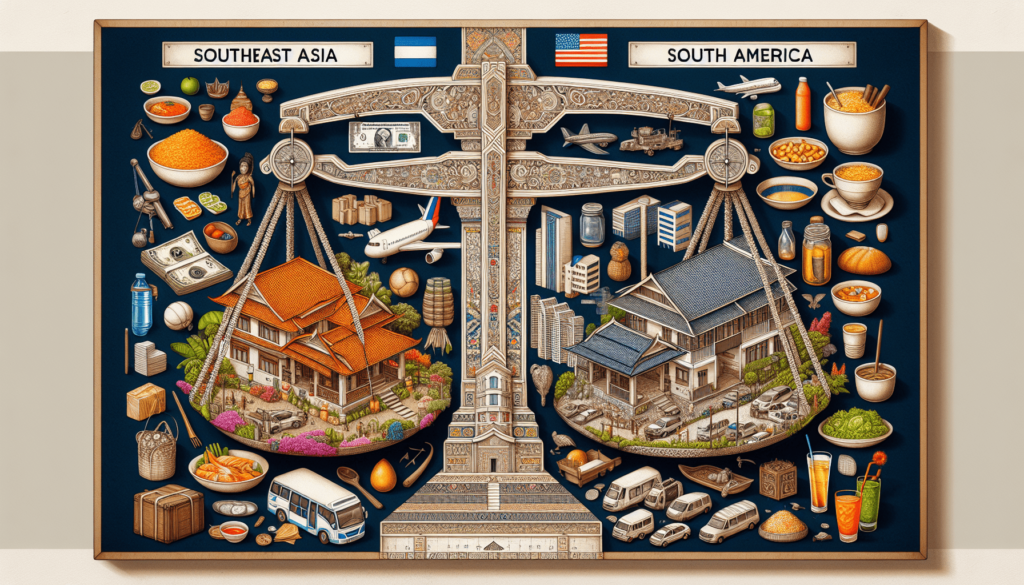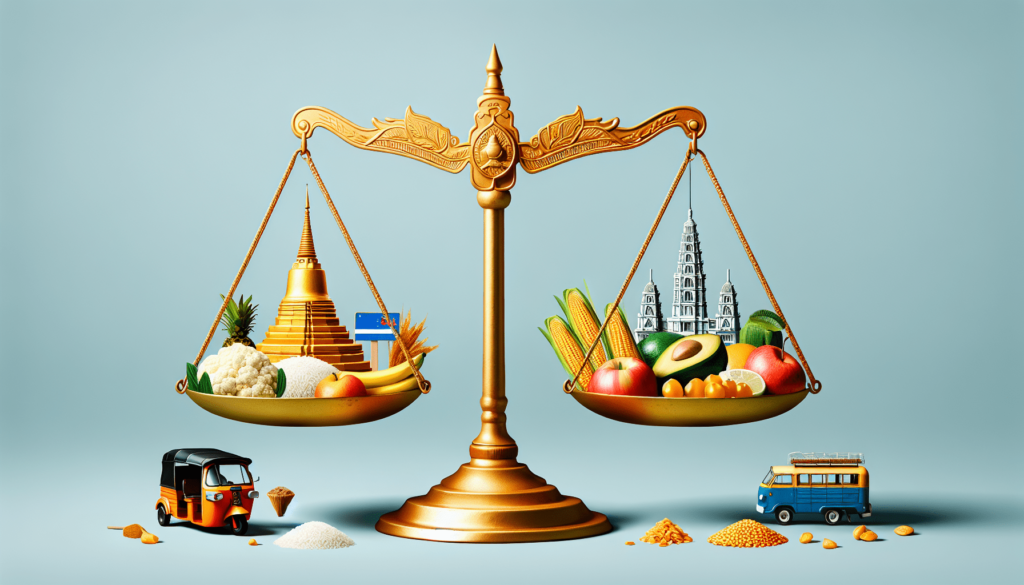If you’ve ever dreamt of exploring new horizons but hesitated due to financial concerns, fret no more! In this informative article, we will compare the cost of living between two marvelous destinations: Southeast Asia and South America. Join us as we take a closer look at these vibrant regions, unravel their hidden secrets, and help you make an informed decision about your next adventure. From mouth-watering street food to breathtaking landscapes, get ready to embark on a virtual journey that will have you craving exploration. So sit back, relax, and let us paint a vivid picture of the cost of living in Southeast Asia versus South America.
Housing
Renting a house or apartment
Renting a house or apartment is a popular option for many people, especially those who are new to a city or are not ready to commit to buying property. In both Southeast Asia and South America, the cost of renting can vary significantly depending on the city and the neighborhood. Generally, renting in Southeast Asia tends to be more affordable compared to South America. In cities like Bangkok, Ho Chi Minh City, or Manila, you can find decent one-bedroom apartments for around $500-$700 per month. However, in major cities in South America like Buenos Aires, Santiago, or Rio de Janeiro, rental prices can be higher, ranging from $700 to $1,000 for a similar-sized apartment in a desirable area.
Buying property
Buying property is another option for those looking to establish more permanent roots and have a long-term investment. In Southeast Asia, the cost of buying property can vary significantly from country to country. For example, in countries like Thailand or Vietnam, it is possible to find relatively affordable properties, with prices ranging from $100,000 to $300,000, depending on the location and type of property. On the other hand, in South America, buying property tends to be more expensive. Major cities like Buenos Aires or Santiago have higher property prices, with an average two-bedroom apartment in a desirable area costing around $300,000 or more.
Cost of utilities
The cost of utilities, such as electricity, water, and internet, also varies between Southeast Asia and South America. In Southeast Asia, the average monthly cost of utilities can range from $50 to $100, depending on the country and the usage. For example, in Thailand, the average monthly bill for electricity, water, and internet for a small apartment can be around $75. In South America, utility costs tend to be slightly higher. In countries like Argentina or Chile, the average monthly cost for utilities can range from $80 to $120, again depending on the size of the property and usage. It is important to note that these costs can fluctuate based on personal consumption habits and the efficiency of the infrastructure in each country.

Transportation
Public transportation
Public transportation is an essential aspect of city living, offering a convenient and often cost-effective way to get around. In Southeast Asia, public transportation systems vary from country to country. In cities like Bangkok, Singapore, or Kuala Lumpur, you can rely on modern and efficient transportation networks consisting of buses, trains, and metros. The cost of using public transportation in Southeast Asia is relatively low, with prices for a single journey ranging from $0.50 to $1. In comparison, South American cities like Buenos Aires, Rio de Janeiro, or Santiago have well-established public transportation systems, including buses, metros, and trams. The cost of a single journey can range from $0.50 to $1.50, depending on the distance traveled.
Owning a vehicle
Owning a vehicle can provide more flexibility and convenience, but it also comes with additional costs. In Southeast Asia, owning a car can be relatively expensive due to high taxes and import duties. However, countries like Thailand and Malaysia have well-developed automotive industries, making it more affordable to purchase locally produced vehicles. In South America, owning a car can also be expensive due to import taxes and the higher cost of vehicles. It is important to consider factors such as fuel prices, maintenance, insurance, and parking fees when calculating the total cost of owning a vehicle in both regions.
Fuel prices
Fuel prices can significantly impact transportation costs. In Southeast Asia, the price of gasoline varies from country to country. In countries like Thailand or Indonesia, gasoline is relatively affordable, with prices ranging from $0.90 to $1.30 per liter. On the other hand, fuel prices in South America tend to be higher. In countries like Argentina or Brazil, gasoline prices can range from $1.20 to $1.70 per liter.
Cost of flights between countries
For those who enjoy traveling or have family and friends in different countries, the cost of flights is an important consideration. Southeast Asia is known for having a well-connected network of low-cost carriers, offering affordable fares for domestic and international flights. For example, a round-trip flight from Bangkok to Bali can cost around $150 to $200, depending on the airline and time of booking. South America also has several low-cost carriers, but the overall cost of flights tends to be higher than in Southeast Asia. A round-trip flight between Buenos Aires and Sao Paulo can cost around $250 to $350, depending on the airline and availability.

Food and Groceries
Average cost of a meal at a restaurant
Eating out at restaurants is a common practice in both Southeast Asia and South America. The average cost of a meal at a mid-range restaurant in Southeast Asia can range from $5 to $10 per person. In countries like Thailand or Vietnam, street food options offer even more affordable options, with a meal costing around $3 or less. In South America, the average cost of a meal at a mid-range restaurant can vary from $8 to $15 per person. Countries like Argentina or Brazil are known for their delicious steakhouses, where the price of a meal can be slightly higher due to the quality of the meat.
Grocery prices
Grocery prices can provide insight into the overall cost of living in a region. In Southeast Asia, the cost of groceries can vary depending on the country and the availability of locally-produced goods. Generally, groceries in Southeast Asia tend to be more affordable compared to South America. For example, the cost of staples like rice, fruits, vegetables, and meat in countries like Thailand or Malaysia can be significantly lower than in South American countries like Argentina or Chile.
Local market prices
Local markets are great places to find fresh produce and unique ingredients. Prices in local markets across Southeast Asia can vary depending on the country and the city. Generally, local market prices in Southeast Asia tend to be more affordable compared to South America. Countries like Thailand or Vietnam are known for their bustling markets, where you can find a wide variety of fruits, vegetables, spices, and other local products at very reasonable prices.
Eating out vs. cooking at home
Deciding between eating out at restaurants or cooking at home can significantly impact your monthly budget. In Southeast Asia, eating out can be quite affordable, especially if you opt for street food or local eateries. However, if you prefer to cook at home, buying groceries and cooking your own meals can be an even more cost-effective option. Similarly, in South America, eating out at mid-range restaurants can be affordable, but cooking at home can help stretch your budget even further. It ultimately comes down to personal preferences and the balance between convenience and cost for each individual.

